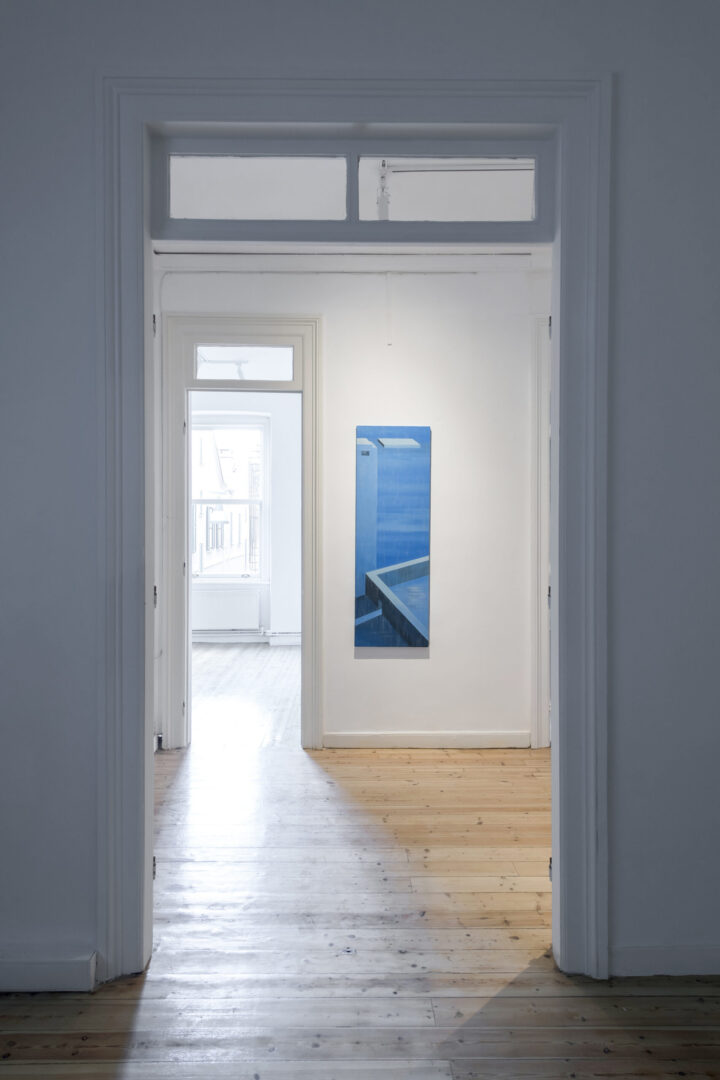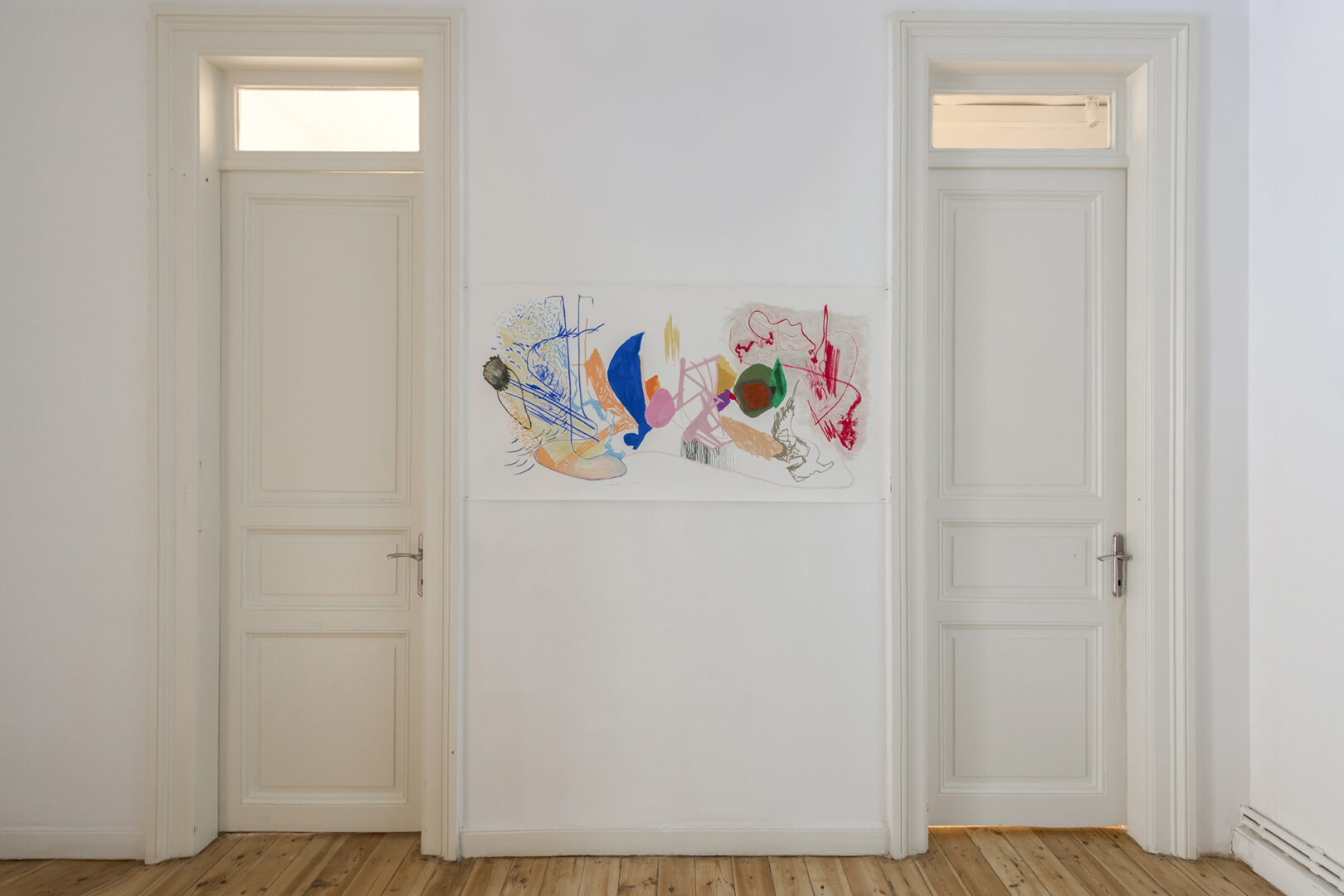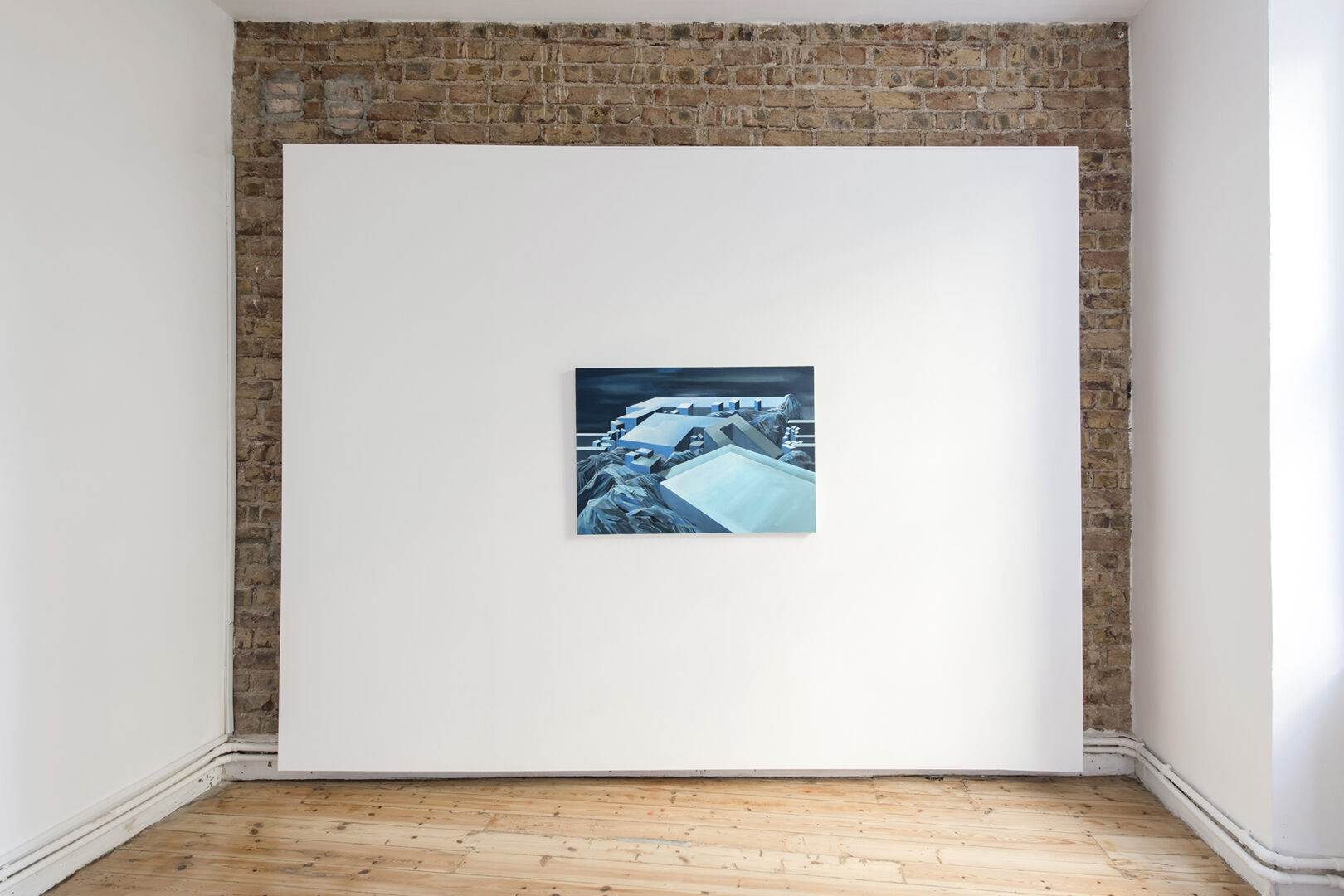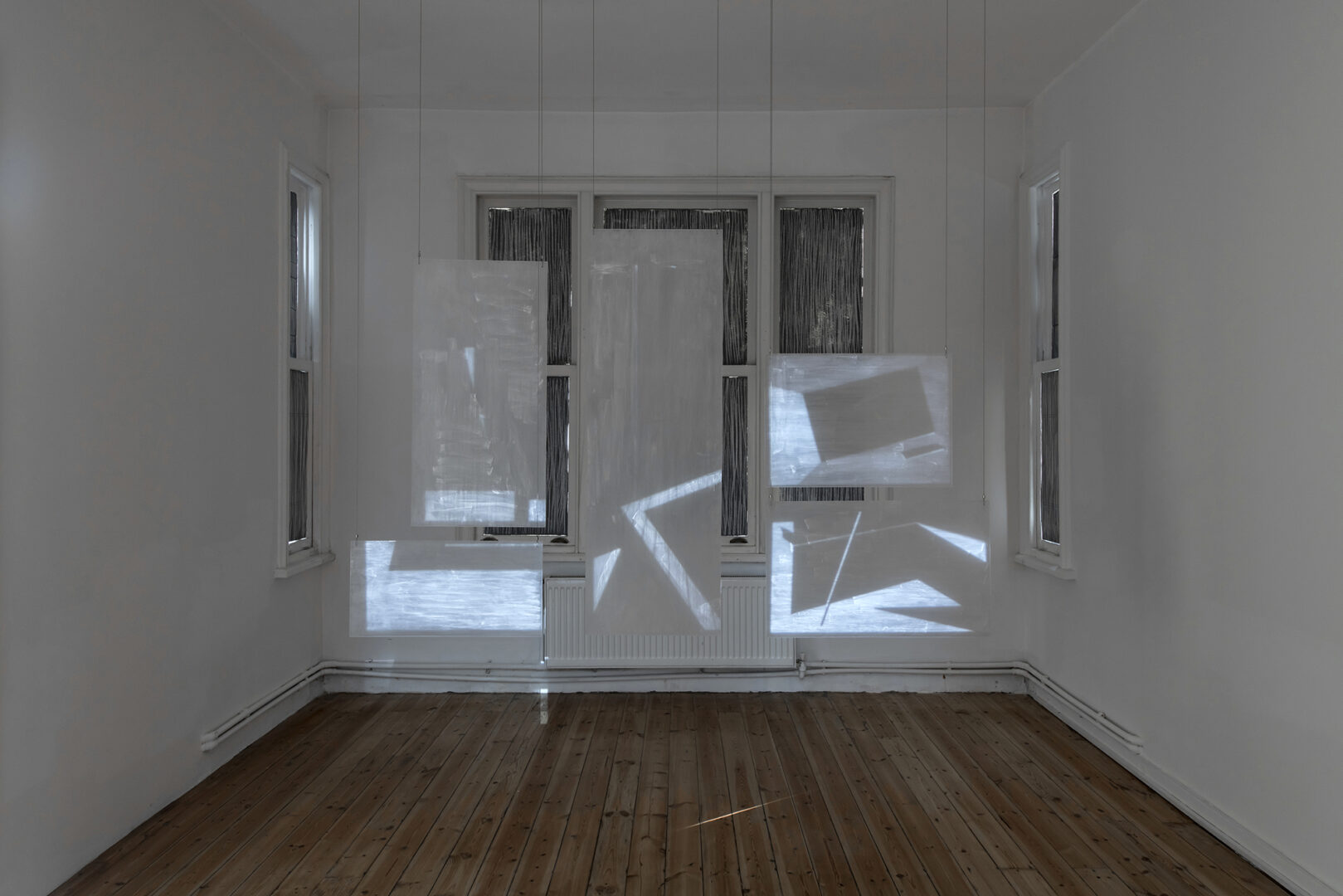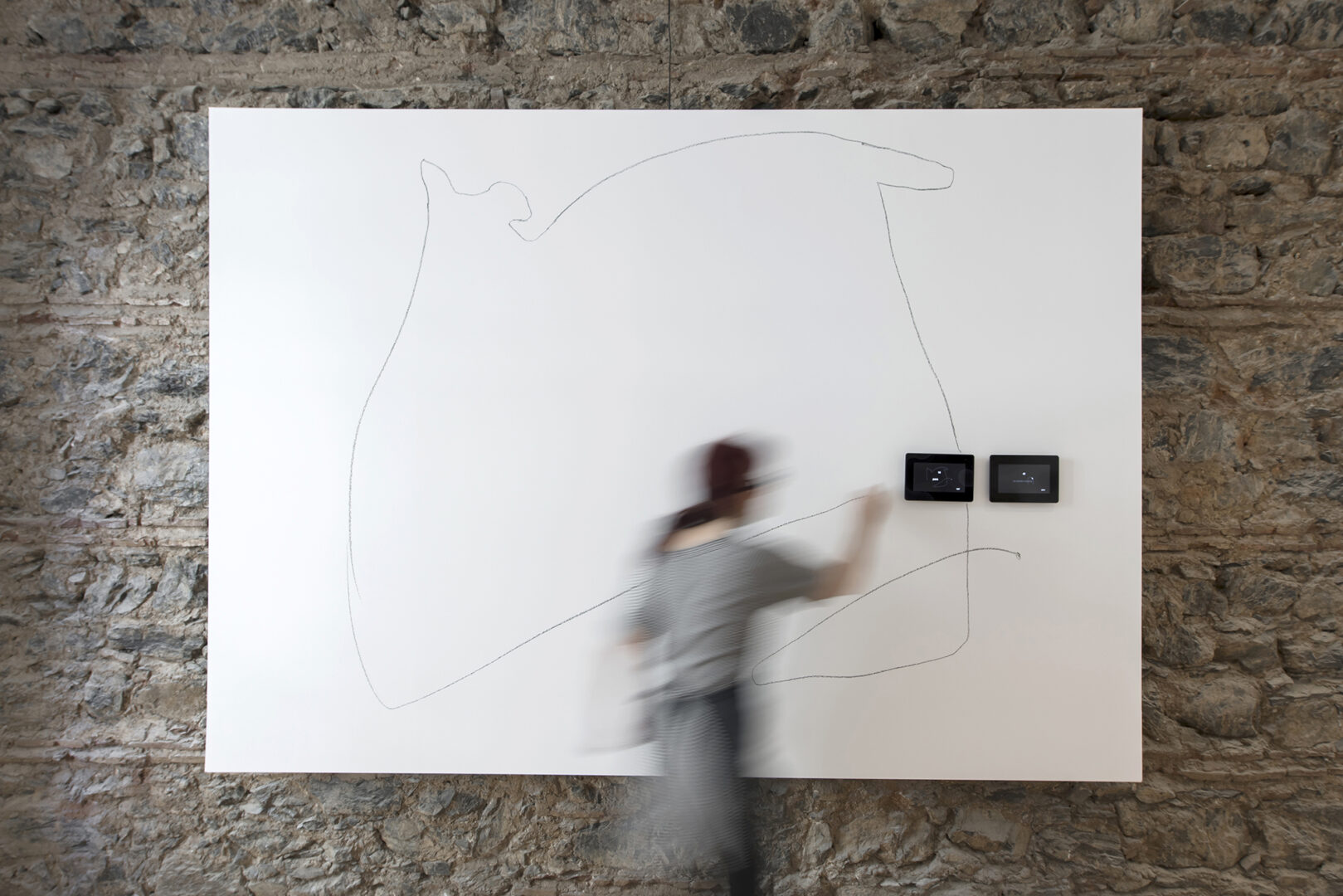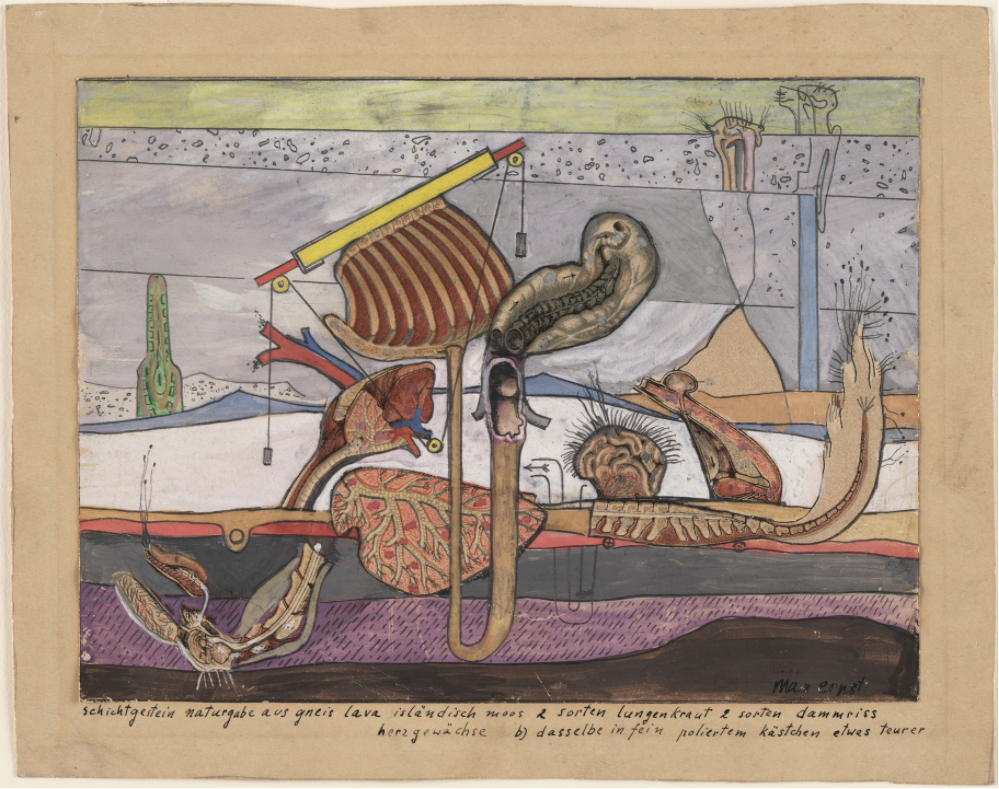The Dance of The Broken Machine
25.09.2020 – 07.011.2020
Artist
Bengü Karaduman
Closing The Loop
All animals need to acquire nutrients, exchange gases, and dispose of waste products in order to keep living. 1 The realization of these functions is the domain of the circulatory system in the body. In closed circulatory systems, those used by vertebrates, including mammals, there is a barrier between the circulatory fluid, blood, and interstitial fluid, and this barrier is called the vessel. Veins, arteries, and capillaries are the three different kinds of vessels and, together with the heart, they make up the cardiovascular system, the circulatory system of a vertebrate.
There are two reference works that Bengu Karaduman and I talked about while she was preparing for the exhibition The Dance of the Broken Machine. One is The Cares of a Family Man,2 a short essay published in 1919. Written from the voice of the first-person narrator, who is the family man mentioned in the title, the essay is an attempt to describe a creature called Odradek. The first paragraph delves into the etymological character of the word Odradek, and the subsequent short paragraphs attempt to describe the look, mechanism, shape, laughter, and at last, the possibility of death and the future for such a creature. There have been multiple interpretations of this essay and Odradek has been analyzed to be many things but whatever Kafka meant for him to be, he is a persistent creature that won’t give up on his existence. He keeps showing up, he is there – almost like background noise, too loud to ignore too silent to make a scene about. As relayed to us in the last paragraph of the essay “Am I to suppose, then, that he will always be rolling down the stairs, with ends of thread trailing after him, right before the feet of my children, and my children’s children?” we are made to believe or at least imagine that Odradek will be there long past our own expiration date.
Odradek’s existence and meaning are open to interpretation in the Kafka essay but we know that it is the essential entity we will with, and couldn’t live without and as such it is akin to the blood. Blood runs constantly through our vessels, we know it is there and as the most essential fluid in our system, it is a constant reminder of our dependence on the structural layout of the vessel system for our survival. Without it running through the arteries, vessels, and capillaries, feeding the cells constantly, we would long be dead, yet it is not something we take notice of on a daily basis. Yet we notice it succinctly the second we fall down and scratch ourselves; we notice it when our blood pressure gets lower, our eyes get tingly as we are getting up; or when our heart starts beating faster as a result of an adrenaline rush. The fact that the slightest change in the outside conditions is reflected in the way that the blood circulates through our body is a sign of its omnipotence and our absolute and precarious dependence on it. What is it in society that functions as blood? What are those exchanges without which we cannot live? Could it be that the economic relations that form the basis of our quotidian exchanges are the essential and fixed elements unwilling to give up and alter themselves? Could it be that Odradek is, as one prominent interpretation puts it, the economic system that we live in, capitalism itself?
Copyright © 2020 Artists Rights Society (ARS), New York / ADAGP, Paris
A second reference work for Karaduman’s exhibition is the Stratified Rocks, Nature’s Gift of Gneiss Lava Iceland Moss 2 kinds of lungwort 2 kinds of ruptures of the perinaeum growths of the heart b) the same thing in a well-polished little box somewhat more expensive (1920)3, a drawing in which Max Ernst modifies the anatomy of a horse from the pages of Bibliotheca Paedagogica (1914). He takes a cross-section of the horse, rotates it 180 degrees, and makes it the foreground around which the drawing takes shape. He puts as the background the geographic cross-section of a landscape that includes the elements listed in the title of the work: amongst other things lava, Iceland moss, lungwort, and stratified rocks. The heart, veins, and arteries of the horse are exposed for us to see, but Ernst does not include the horse in its entirety, but rather the head, the heart, the lungs, partially the skeleton and the tail. Missing are the legs as well as the lower section below the heart and the lungs.
Thus the vessels that we see are not uninterrupted: They do not close the loop, such that the circulatory system would carry the blood being pumped out of the heart, running through the arteries, carrying oxygen and nutrients to the cells and exchanging these with the other gases and waste products through osmosis at the capillaries and finally closing the loop by way of the veins taking the oxygen-poor and waste rich blood back to the atrium of the heart. The vessels are cut short in this drawing by Ernst, and we never see the vessels reaching the feet or the bottom sections of the body. Instead, there is a mechanical structure resembling a pulley placed on top of the inverted cross-section of the horse such that the pulley becomes the bottom section of the body. It’s almost an effort to close the loop of the circulatory system by welding the veins/arteries with the lining of the pulley cord. This attempt at fusing a certain man-made contraption with the organically occurring vessel structure is further amplified when Ernst juxtaposes this hybrid man-made/organic contraption with the geographical strata in the background.
This juxtaposition of the man-made, the organically occurring, and nature could be read in the context of a Dada tradition (to which Ernst intermittently belongs and from which he borrows tools for manipulation) called pataphysics. Pataphysics was coined by the author Alfred Jarry in his book “The Exploits and Opinions of Dr Faustroll, Pataphysician” (1914) to refer to a “science of imaginary solutions” that would “examine the laws governing exceptions.” In an era of the introduction and higher presence of not-before-seen/not-before-used machines of the early 20th century, it’s apt that there were conceptions of what they could be used for. Utopian or (less so) dystopian, these re-imaginings often tried to solve long-standing problems of humankind, the idea being that the newly emerging technologies were prone to integrate and alter the existing human mechanism. The longevity vs. the inefficiencies of a system has been a cornerstone of artistic preoccupation for many centuries. We live in the early 21st century, where yet again the relationship between the man-made and the organic is shifting in ever-fragile ways and we anticipate the next waves of digitization with anxiety, going back to Ernst’s drawing reminds us of the tradition and presence of confusion and uncertainty at each epoch of such accelerated technological turn throughout the human story.
At its core, this 19.1 x 24.1 cm gouache and pencil drawing is the crafting of a new (world) order, the observing of new arrangements of the vessels in the circulatory system, and thus the system itself. Ernst, in this work, is testing out the connecting and intertwining together of the organic blood vessels of the horse to the artificial lining of the pulley cord. He is trying to figure out if there will be any reactions that may arise from the introduction of the man-made pseudo-vessels to the circulatory system. Not unlike the introduction of a coronary or a vascular stent into the circulatory system with the aim to keep the arteries open or treat the abnormal narrowing or deformation of the arteries, he is trying to see whether such a new arrangement of the circulatory system would run smoothly, whether a system error occurs and if not, whether one can conclude confidently that the new arrangement is a substantial improvement of the earlier arrangement.
The questioning of the incorporation of new components and the fusing of these new elements with the already existing ones is at the core of Ernst’s work. It is the hybridization and the effects of such alteration that the work contemplates about. On the other hand, the omnipresence of a system, the state of being at the mercy of any changes in that system, and the fragility and uncertainty that comes with that state are at the core of the Kafka essay. Bengu Karaduman’s work deals with both of these concerns, taking up issues of the fragility of being knowledge labourers at the mercy of a heavy-handed system while at the same time questioning and posing possibilities towards a modified system which incorporates technological reformations. In relationship to one another, these two concerns spell out the most urgent issues of the day, especially in re-imagining a just and ethical labour system.
Text: Zeynep Öz
Exhibition Design: Murat Fesih Avcıbaşı
1 All biology information on these pages are acquired in conversation with and through the lessons of Dünya Önen for the larger project Towards a CSA Model in the Arts and with the help of the book: Taylor, Martha R., Simon, Eric J., Dickey, Jean L., Hogan, Kelly A., and Reece, Jane B., 2018, Campbell Biology: Concepts & Connections 9/E, Pearson Education.
2 Kafka, Franz. 1995. “The Cares of a Family Man” The Complete Stories. Translated by Willa and Edwin Muir. New York City: Schocken Books, 473.
3 Max Ernst, Stratified Rocks, Nature’s Gift of Gneiss Lava Iceland Moss 2 kinds of lungwort 2 kinds of ruptures of the perinaeum growths of the heart b) the same thing in a well-polished little box somewhat more expensive (schichtgestein naturgabe aus gneis lava isländisch moos 2 sorten lungenkraut 2 sorten dammriss/herzgewächse b) dasselbe in fein poliertem kästchen etwas teurer), 1920, Collection, MoMA: https://www.moma.org/collection/works/35951
Döngüyü Tamalamak
Yaşamaya devam etmek için bütün hayvanların besin maddelerine ulaşmak, gaz değişimi yapmak ve atık materyali uzaklaştırmaya ihtiyacı vardır.1 Bu işlevlerin yerine getirilmesi, vücuttaki dolaşım sisteminin alanıdır. Memeliler dahil tüm omurgalılarda görülen kapalı dolaşım sistemlerinde dolaşım sıvısı, kan ve doku sıvısı arasında bir bariyer bulunur. Bu bariyere damar denir. Kılcal, atar ve toplar damar olmak üzere üç farklı taşıma aracı vardır ve kalple birlikte bunlar kardiyovasküler sistemi, omurgalılardaki dolaşım sistemini oluştururlar.
Bozuk Makinenin Dansı sergisi için hazırlandığı esnada Bengü Karaduman’la iki referans eser üzerine konuştuk. İlki, 1919’da yayınlanmış kısa bir deneme olan Bir Aile Babasının Kaygıları 2–. Birinci şahıs anlatıcının, yani başlıkta geçen aile babasının ağzından yazılmış olan deneme, Odradek adında bir yaratığı tasvir etme çabasıdır. İlk paragrafta Odradek kelimesinin etimolojik karakteri irdelenirken, ardından gelen kısa paragraflarda ise bu yaratığın görünüşü, işleyişi, şekli, gülüşü ve nihayet ölme ihtimali ve geleceği anlatılıyor. Bu deneme çeşitli şekillerde yorumlanmış ve Odradek üzerine çeşitli şeyler olduğuna dair analizler yapılmıştır. Kafka bu yaratık için her ne kast etmiş olursa olsun, kendisi varlığından vazgeçmeyi reddeden, ısrarcı bir yaratıktır. Gitse de geri gelir, hep oradadır – adeta fon gürültüsü gibi, yok sayılamayacak kadar yüksek ama konu edilemeyecek kadar alçak bir ses. Denemenin son paragrafında verilen “O halde ben onun hep merdivenlerden, peşinden iplik uçları sürüklenir bir şekilde, çocuklarımın ve torunlarımın önüne düşeceğini mi varsaymalıyım?” anlatısı, okuyucuya Odradek’in bizlerin son gününden çok daha sonra hala orada olacağına inanmamızı ya da en azından hayal etmemizi sağlar.
Kafka’nın denemesinde Odradek’in varlığı ve ne anlama geldiği yoruma açıktır, fakat biz biliriz ki bu yaratık bizim onsuz yaşayamayacağımız asli varlıktır, bu haliyle de kan ile benzerlik gösterir. Kan sürekli damarlarda akar, orada olduğu bilinir ve vücuttaki en temel sıvı olarak, hayatta kalmanın damar sisteminin yapısal düzenine bağlı olduğuna dair sürekli bir hatırlatmadır. Atar, toplar ve kılcal damarlarda akan kan sürekli bir şekilde hücreleri beslemeseydi çoktan ölmüş olurduk, ama bu gündelik hayatta pek farkında olmadığımız bir durumdur. Bunu düştüğümüz an, bir yerimiz sıyrıldığında, tansiyonumuz düştüğünde, ayağa kalkarken gözümüz kararınca veya gelen adrenalin seliyle kalbimiz daha hızlı atmaya başlayınca fark ederiz. Dış dünya şartlarındaki en ufak bir değişimin kanımızın bedenimizde nasıl dolaştığını etkilemesi, kanın kadiri mutlak haline ve bizim ona olan mutlak ve kırılgan bağımlılığımızı gösterir. Peki, toplumda kanın işlevini gören şey nedir? Onlarsız yaşayamayacağımız etkileşimler nelerdir? Gündelik alışverişimizin temelini oluşturan ekonomik ilişkiler, kendilerinden vazgeçmeye veya değişmeye niyeti olmayan temel ve sabit unsurlar olabilir mi? Yoksa, önemli bir yorumda da anlatıldığı üzere, Odradek, içinde yaşadığımız ekonomik sistem, yani bizzat kapitalizm midir?
Copyright © 2020 Artists Rights Society (ARS), New York / ADAGP, Paris
Karaduman’ın sergisine dair ikinci referans eser de Stratified Rocks, Nature’s Gift of Gneiss Lava Iceland Moss 2 kinds of lungwort 2 kinds of ruptures of the perinaeum growths of the heart b) the same thing in a well-polished little box somewhat more expensive (1920)3: Max Ernst’in Bibliotheca Paedagogica’nın (1914) sayfalarında bulduğu bir atın anatomisini modifiye ettiği bir çizim. Atın kesitini alır, 180 derece döndürerek çizimin şekillendiği ön plan olarak kullanır. Fon olarak, işin başlığında bahsi geçen unsurları içeren bir manzaranın coğrafi kesitini koyar. Bunların arasında lav, İzlanda yosunu, ciğerotu ve katmanlı kayalar vardır. Atın kalbi ile atar ve toplar damarları izleyicinin görmesi için açıkta bırakılmış, fakat Ernst atı kendi bütünlüğü içerisinde kullanmaz, bunun yerine kafası, kalbi, ciğerleri, iskeletinin bir kısmını ve kuyruğu vardır. Bacaklarının yanısıra kalple akciğerlerinin altında kalan kısmı eksiktir.
Dolayısıyla, gördüğümüz damarlar kesintisiz değildir ve kanın atar damarlardan akarak hücrelere oksijen ve besin maddesi götürüp hücrenin gaz ve diğer atıklarını kılcal damarlardaki ozmos ile iade alarak, damarlar üzerinden oksijensiz ve atık dolu kanın kalp kulakçığına tamamlandığı dolaşım sistemindeki gibi döngüyü tamamlamaz. Ernst’in çiziminde kısa kesilmiş olan damarların ayaklara veya vücudun alt kısımlarına ulaştıklarını asla görmeyiz. Bunun yerine, ters çevrilmiş at kesitinin üzerine yerleştirilmiş makara benzeri mekanik bir sistem, vücudun alt kısmı haline gelir. Dolaşım sisteminin döngüsünü damarlar ve atar damarları makara halatıyla lehimleyerek kapatmak çaba gerektirir. Bu insan yapımı bir aygıtı organik olarak ortaya çıkan damar yapısıyla birleştirme çabası, Ernst insan yapımı/organik melezi bu icadını fondaki coğrafi katmanlarla yan yana koyunca daha da belirginleşir.
İnsan yapımının, organik olarak ortaya çıkanın ve doğanın bu yan yana gelişi, Ernst’in ara ara dahil olduğu ve manipülasyon için kendisinden araçlar ödünç aldığı patafizik denen Dada geleneği bağlamında okunabilir. Patafizik kelimesi ilk olarak yazar Alfred Jarry tarafından “Patafizikçi Dr Faustroll’ün Davranış ve Görüşleri” (1914) adlı kitabında, “istisnaları belirleyen, kanunları irdeleyen muhayyel çözümlerin bilimi” anlamında kullanılmıştır. Daha önce görülmemiş/kullanılmamış makinelerin ortaya çıktığı ve yaygınlaştığı erken 20. yüzyılda, bu makinelerin ne işe yarayabileceğine dair fikir yürütülmesi yerinde olmuştur. Bu ütopyacı veya (daha nadir olarak) distopyacı tasavvurlar, yeni geliştirilen teknolojilerin mevcut insan mekaniğine entegre olup onu değiştirmeye teşne olduğu fikrinden hareketle, sıklıkla insanlığın kadim sorunlarını çözmeye çalışmıştır. Uzun yüzyıllar boyunca, sanatsal kaygının köşe taşlarından biri, bir sistemin dayanıklılığıyla yetersizliklerini karşılaştırmak olmuştur. Bizler erken 21. yüzyılda yaşıyoruz ve insan yapımıyla organik arasındaki ilişki bir kez daha narin biçimlerde değişir. Bizler yeni gelecek dijitalleşme dalgalarını kaygıyla beklerken, Ernst’in çizimine dönmek bize insanlığın öyküsü boyunca teknolojik gelişimin ivmelendiği her dönemeç çağında bulunan kafa karışıklığı ve belirsizlik geleneğini hatırlatıyor.
Özünde, bu 19.1 x 24.1 cm guaş ve karakalem çizim yeni bir (dünya) düzen (in)in yaratılma hali, dolaşım sistemindeki yeni ayarlamaların, dolayısıyla sistemin kendisinin gözlemlenmesidir. Ernst, bu işinde atın organik damarlarıyla makara halatının yapay kaplamasını birleştirme ve birbirine dolamanın denemelerini yapmıştır. Dolaşım sistemine insan yapımı yalancı damarlar eklenmesine tepki gelip gelmeyeceğini çözmeye çalışmaktadır. Dolaşım sisteminde atar damarları açık tutmak veya damarların anormal daralma/deforme olmasını tedavi etmek amacıyla bir kalp veya damar stendi eklenmesinden çok farklı olmayan biçimde, dolaşım sisteminin bu yeni düzenleme altında düzgün çalışıp çalışmayacağını, bir hatanın ortaya çıkıp çıkmayacağını, kişinin gönül rahatlığıyla yeni düzenlemenin eskisine göre nitelikli bir iyileşme oluşturduğu kanaatine varıp varamayacağını görmeye çalışmıştır.
Yeni bileşenlerin sisteme dahil edilmesi ve bu yeni unsurların mevcut unsurlarla birleştirilmesi, Ernst’in eserinin temelini oluşturur. Eser, böylesi bir melezleştirme ve bu tadilatın etkileri üzerine düşünür. Diğer yandan, Kafka denemesinin özünde bir sistemin her yerde bulunması, sistemde ortaya çıkacak herhangi bir değişimin insafına kalma hali, ve bu halin getirdiği kırılganlık ve belirsizlik vardır. Bengü Karaduman’ın eseri, zalim bir sistemin insafında bilgi emekçisi olma kırılganlığını ve aynı zamanda sorgulama ve teknolojik reformları dahil eden modifiye edilmiş bir sisteme dair ihtimalleri sorgulama ve sunma kaygılarının ikisine de değinir. Birbirleriyle ilişkili olarak, bu iki kaygı günümüzün en acil meselelerini ifade eder, özellikle adil ve ahlaki bir emek sisteminin yeniden tahayyülünde.
Metin: Zeynep Öz
Sergi Tasarım: Murat Fesih Avcıbaşı
1 Bu sayfalarda kullanılan tüm biyoloji bilgileri, Towards a CSA Model in the Arts adlı proje kapsamında Dünya Önen ile yapılan konuşmalar ve dersler sırasında ve Campbell Biyoloji kitabının desteğiyle elde edilmiştir. Taylor, Martha R., Simon, Eric J., Dickey, Jean L., Hogan, Kelly A., ve Reece, Jane B., 2018, Campbell Biyoloji: Kavramlar ve Bağlantılar 9/E (Campbell Biology: Concepts & Connections 9/E), Pearson Education Yayıncılık. Towards a CSA Model in the Arts: https://www.baharadogru.com/towards-a-csa-model-in-the-arts
2 Kafka, Franz. 1995. Orijinal “Die Sorge des Hausvaters”, İngilizce Çeviri “The Cares of a Family Man” (The Complete Stories) Çevirmen: Willa and Edwin Muir. New York: Schocken Books Yayınevi, 473.
3 Max Ernst, Katmanlı Kayalar, Doğanın Gneiss Lava İzlanda Yosunu Hediyesi 2 çeşit ciğer otu 2 çeşit perineal kalp kitlesi rüptürü b) aynı şey etraflıca parlatılmış minik bir kutuya konmuş nedense daha pahalı (schichtgestein naturgabe aus gneis lava isländisch moos 2 sorten lungenkraut 2 sorten dammriss/herzgewächse b) dasselbe in fein poliertem kästchen etwas teurer), 1920, Koleksiyon, MoMA: https://www.moma.org/
